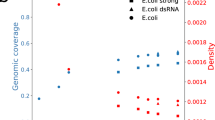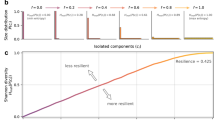Abstract
Protein networks, describing physical interactions as well as functional associations between proteins, have been unravelled for many organisms in the recent past. Databases such as the STRING provide excellent resources for the analysis of such networks. In this contribution, we revisit the organisation of protein networks, particularly the centrality–lethality hypothesis, which hypothesises that nodes with higher centrality in a network are more likely to produce lethal phenotypes on removal, compared to nodes with lower centrality. We consider the protein networks of a diverse set of 20 organisms, with essentiality information available in the Database of Essential Genes and assess the relationship between centrality measures and lethality. For each of these organisms, we obtained networks of high-confidence interactions from the STRING database, and computed network parameters such as degree, betweenness centrality, closeness centrality and pairwise disconnectivity indices. We observe that the networks considered here are predominantly disassortative. Further, we observe that essential nodes in a network have a significantly higher average degree and betweenness centrality, compared to the network average. Most previous studies have evaluated the centrality–lethality hypothesis for Saccharomyces cerevisiae and Escherichia coli; we here observe that the centrality–lethality hypothesis hold goods for a large number of organisms, with certain limitations. Betweenness centrality may also be a useful measure to identify essential nodes, but measures like closeness centrality and pairwise disconnectivity are not significantly higher for essential nodes.


Similar content being viewed by others
References
Barabási A-L, Oltvai ZN (2004) Network biology: understanding the cell’s functional organization. Nat Rev Genet 5:101–113. doi:10.1038/nrg1272
Batada NN, Hurst LD, Tyers M (2006) Evolutionary and physiological importance of hub proteins. PLoS Comput Biol 2:e88. doi:10.1371/journal.pcbi.0020088
Boccaletti S, Latora V, Moreno Y et al (2006) Complex networks: structure and dynamics. Phys Rep 424:175–308. doi:10.1016/j.physrep.2005.10.009
Flórez AF, Park D, Bhak J et al (2010) Protein network prediction and topological analysis in Leishmania major as a tool for drug target selection. BMC Bioinformatics 11:484. doi:10.1186/1471-2105-11-484
Freeman LC (1977) A set of measures of centrality based on betweenness. Sociometry 40:35–41. doi:10.2307/3033543
He X, Zhang J (2006) Why do hubs tend to be essential in protein networks? PLoS Genet 2:e88. doi:10.1371/journal.pgen.0020088
Holme P, Kim B, Yoon C, Han S (2002) Attack vulnerability of complex networks. Phys Rev E65:056109. doi:10.1103/PhysRevE.65.056109
Jeong H, Mason SP, Barabási AL, Oltvai ZN (2001) Lethality and centrality in protein networks. Nature 411:41–42. doi:10.1038/35075138
Joyce AR, Palsson BØ (2008) Predicting gene essentiality using genome-scale in silico models. Methods mole biol (Clifton, NJ) 416:433–457. doi:10.1007/978-1-59745-321-9_30
Kauffman KJ, Prakash P, Edwards JS (2003) Advances in flux balance analysis. Curr Opin Biotechnol 14:491–496. doi:10.1016/j.copbio.2003.08.001
Newman M (2002) Assortative mixing in networks. Phys Rev Lett 89:208701. doi:10.1103/PhysRevLett.89.208701
Newman MEJ (2003a) Mixing patterns in networks. Phys Rev E 67:026126. doi: 10.1103/physreve.67.026126
Newman MEJ (2003b) The structure and function of complex networks. SIAM Rev 45:167–256. doi:10.1137/S003614450342480
Ning K, Ng H, Srihari S et al (2010) Examination of the relationship between essential genes in PPI network and hub proteins in reverse nearest neighbor topology. BMC Bioinformatics. doi:10.1186/1471-2105-11-505
Potapov AP, Goemann B, Wingender E (2008) The pairwise disconnectivity index as a new metric for the topological analysis of regulatory networks. BMC Bioinformatics 9:227. doi:10.1186/1471-2105-9-227
Rodrigues FA, da Costa LF, Barbieri AL (2011) Resilience of protein–protein interaction networks as determined by their large-scale topological features. Mol BioSyst 7:1263–1269. doi:10.1039/c0mb00256a
Roy S (2012) Systems biology beyond degree, hubs and scale-free networks: the case for multiple metrics in complex networks. Syst Synth Biol 6:31–34. doi:10.1007/s11693-012-9094-y
Roy S, Filkov V (2009) Strong associations between microbe phenotypes and their network architecture. Phys Rev E80:040902. doi:10.1103/PhysRevE.80.040902
Sabidussi G (1966) The centrality index of a graph. Psychometrika 31:581–603. doi:10.1007/BF02289527
Shoemaker BA, Panchenko AR (2007a) Deciphering protein–protein interactions. Part I. experimental techniques and databases. PLoS Comput Biol 3:e42. doi:10.1371/journal.pcbi.0030042
Shoemaker BA, Panchenko AR (2007b) Deciphering protein–protein interactions. Part II. computational methods to predict protein and domain interaction partners. PLoS Comput Biol 3:e43. doi:10.1371/journal.pcbi.0030043
Song J, Singh M (2013) From hub proteins to hub modules: the relationship between essentiality and centrality in the yeast interactome at different scales of organization. PLoS Comput Biol 9:e1002910. doi:10.1371/journal.pcbi.1002910
Szklarczyk D, Franceschini A, Kuhn M et al (2011) The STRING database in 2011: functional interaction networks of proteins, globally integrated and scored. Nucleic Acids Res 39:D561–D568. doi:10.1093/nar/gkq973
Verkhedkar KD, Raman K, Chandra NR, Vishveshwara S (2007) Metabolome Based Reaction Graphs of M. tuberculosis and M. leprae: a Comparative Network Analysis. PLoS ONE. doi:10.1371/journal.pone.0000881
Xenarios I, Salwínski L, Duan XJ et al (2002) DIP, the Database of Interacting Proteins: a research tool for studying cellular networks of protein interactions. Nucleic Acids Res 30:303–305. doi:10.1093/nar/30.1.303
Acknowledgments
Funding from IIT Madras and the seed grant BIO/12-13/579/NFSC/KARH is gratefully acknowledged. KR wishes to thank Dr. Saketha Nath (IIT Bombay) for several useful discussions.
Conflict of interest
The authors declare that they have no conflict of interest.
Author information
Authors and Affiliations
Corresponding author
Additional information
Nandita Damaraju and Govind Krishna Joshi have contributed equally to this article.
Electronic supplementary material
Below is the link to the electronic supplementary material.
11693_2013_9123_MOESM1_ESM.pdf
Supplementary material Variation in fraction of essential nodes, with increase in degree. The horizontal axis represents increasing node degrees, indicated as percentiles (x), while the vertical axis indicates the fraction of essential nodes in \(N_{x}^{d}\) , the set of nodes with degrees in the xth percentile and above. (PDF 38 kb)
11693_2013_9123_MOESM2_ESM.pdf
Supplementary material Variation in fraction of essential nodes, with increase in betweenness centrality. The horizontal axis represents increasing node betweenness centralities, indicated as percentiles (x), while the vertical axis indicates the fraction of essential nodes in \(N_{x}^{bc}\), the set of nodes with betweenness centralities in the xth percentile and above. (PDF 299 kb)
11693_2013_9123_MOESM3_ESM.pdf
Supplementary material Variation in fraction of essential nodes, with increase in closeness centrality. These plots are similar to those in Online Resources 1 and 2. (PDF 466 kb)
11693_2013_9123_MOESM4_ESM.pdf
Supplementary material Variation in fraction of essential nodes, with increase in pairwise disconnectivity index. These plots are similar to those in Online Resources 1 and 2. (PDF 26 kb)
Rights and permissions
About this article
Cite this article
Raman, K., Damaraju, N. & Joshi, G.K. The organisational structure of protein networks: revisiting the centrality–lethality hypothesis. Syst Synth Biol 8, 73–81 (2014). https://doi.org/10.1007/s11693-013-9123-5
Received:
Revised:
Accepted:
Published:
Issue Date:
DOI: https://doi.org/10.1007/s11693-013-9123-5




